Okinawa World is a theme park showcasing Okinawan culture. The park features a massive natural cave (Gyokusendo Cave), a craft village with workshops, and a snake museum. The cave offers spectacular stalactites and stalagmites, while the kingdom village demonstrates traditional crafts like weaving and pottery. Visitors can also explore the Habu Park, which includes a snake show, souvenir shops, and local cuisine restaurant.
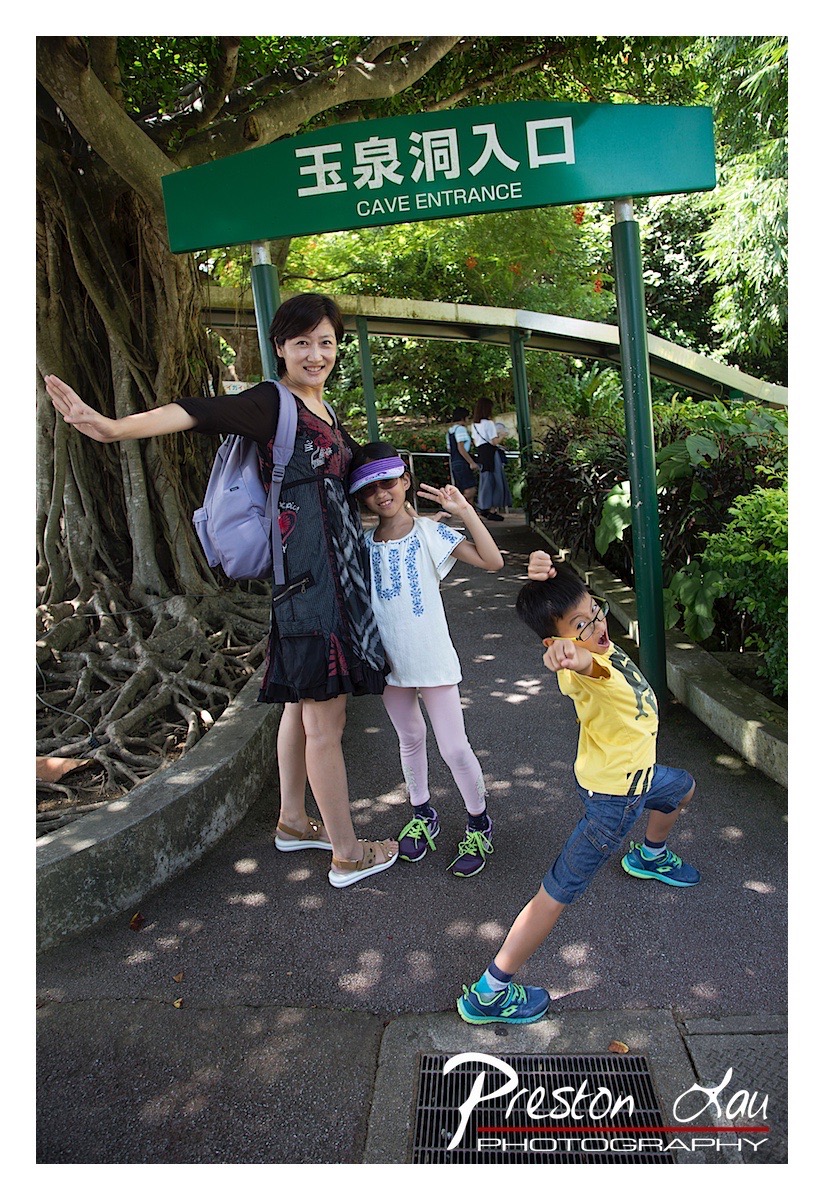

Cave Entrance Chaos: Posing Prodigies and Parental Patience
Rating: 7/10
This lively family portrait captures a moment of playful energy right outside a "CAVE ENTRANCE." The primary subjects, a mother and her two children, are arranged dynamically along the walkway. The mother stands somewhat calmly with one arm extended, perhaps directing or indicating something, while simultaneously managing a backpack and a stylish, layered dress. To her right, a young girl beams with a peace sign, wearing a purple visor, a white embroidered top, and bright pink leggings, radiating pure childhood enthusiasm. The star of the show, though, is the young boy in front, striking a superhero pose in a yellow t-shirt and denim shorts, glasses slightly askew, aiming a dramatic punch towards the viewer. The mood is definitely lighthearted and fun, bordering on chaotic, perfectly reflecting the spontaneous spirit of family travel.
From a photographic perspective, the composition uses the path and the green sign as leading lines towards the presumed entrance. The subjects are well-separated, creating a dynamic triangle. Lighting is a bit harsh, typical of daytime outdoor shots, resulting in some strong shadows on the ground and potentially blown-out highlights in the background foliage, though the subjects are relatively well-exposed. The colors are quite vibrant, especially the children's clothing and the lush greenery. While the focus seems sharp on the family, the deep roots of the large tree on the left and the detailed signage are also clear. The watermark is prominently placed over the grate in the foreground, which is functional but slightly distracting, though it is a common practice for photographers sharing work online. Overall, it's a well-captured moment of family fun, even if the poses are a tad over-the-top – exactly what you'd expect from kids at a potentially exciting destination!
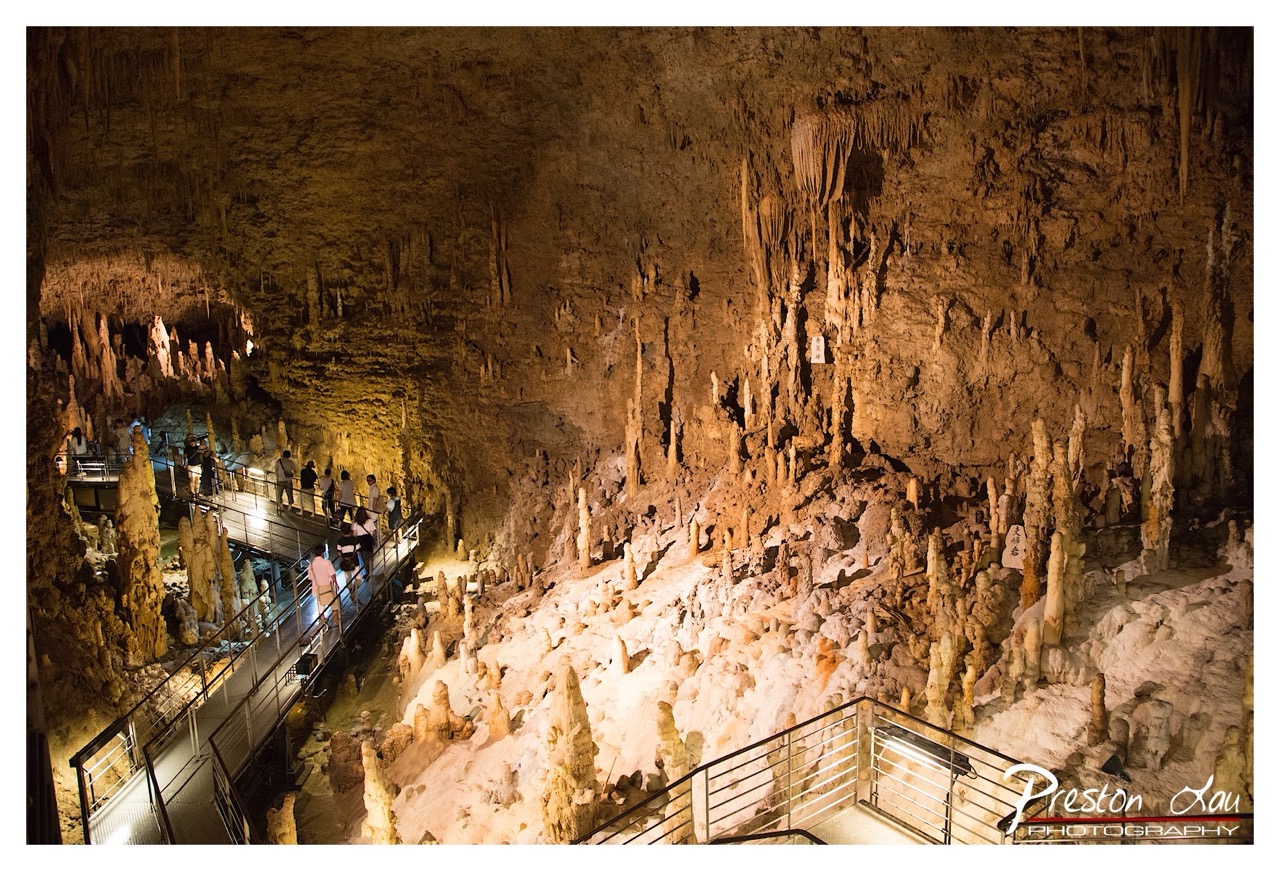

Cave Explorer's Delight (or Tripping Hazard)
Subject Rating: 8/10
Step right up and prepare to be amazed, or maybe just watch your step on this rather practical-looking metal walkway winding through a subterranean wonderland! This shot gives us a grand view of a massive cave system, teeming with incredible stalactites dripping from the ceiling and stalagmites reaching up from the floor like geological candles that have been burning for millennia. A small group of intrepid explorers (likely debating the structural integrity of the railing or whether their phone flashlights are *really* necessary) are making their way along the path, dwarfed by the sheer scale of the cavern. The mood is one of awe-inspiring natural beauty mixed with the slightly mundane reality of guided tours – you can almost hear the distant echo of a guide's voice explaining flowstones. Pertinent objects include the formations, the surprisingly well-lit walkway, and the tiny humans providing a sense of scale and a touch of accidental photo-bombing. The background is, well, more cave – a vast, textured expanse of rock stretching into the dimly lit distance.
From a photographer's perspective, the composition works well, using the diagonal lines of the walkway to lead the eye into the scene and convey depth. The lighting, while necessary for visibility, is predominantly artificial and warm, which nicely accentuates the earthy tones of the rock formations, giving them a golden, almost fiery glow. However, while it highlights the textures beautifully, it does create some rather flat areas on the ceiling and walls. The style leans towards documentary/travel photography, capturing the essence of the location and the human interaction with it. The subject matter itself is fascinating, offering a complex tapestry of shapes and forms created by nature over eons. It's a challenging environment to shoot with limited and mixed lighting, and this capture does a solid job of conveying the scale and texture, even with the slight distraction of the watermark subtly claiming ownership over this geological masterpiece (because who *really* owns a cave?).
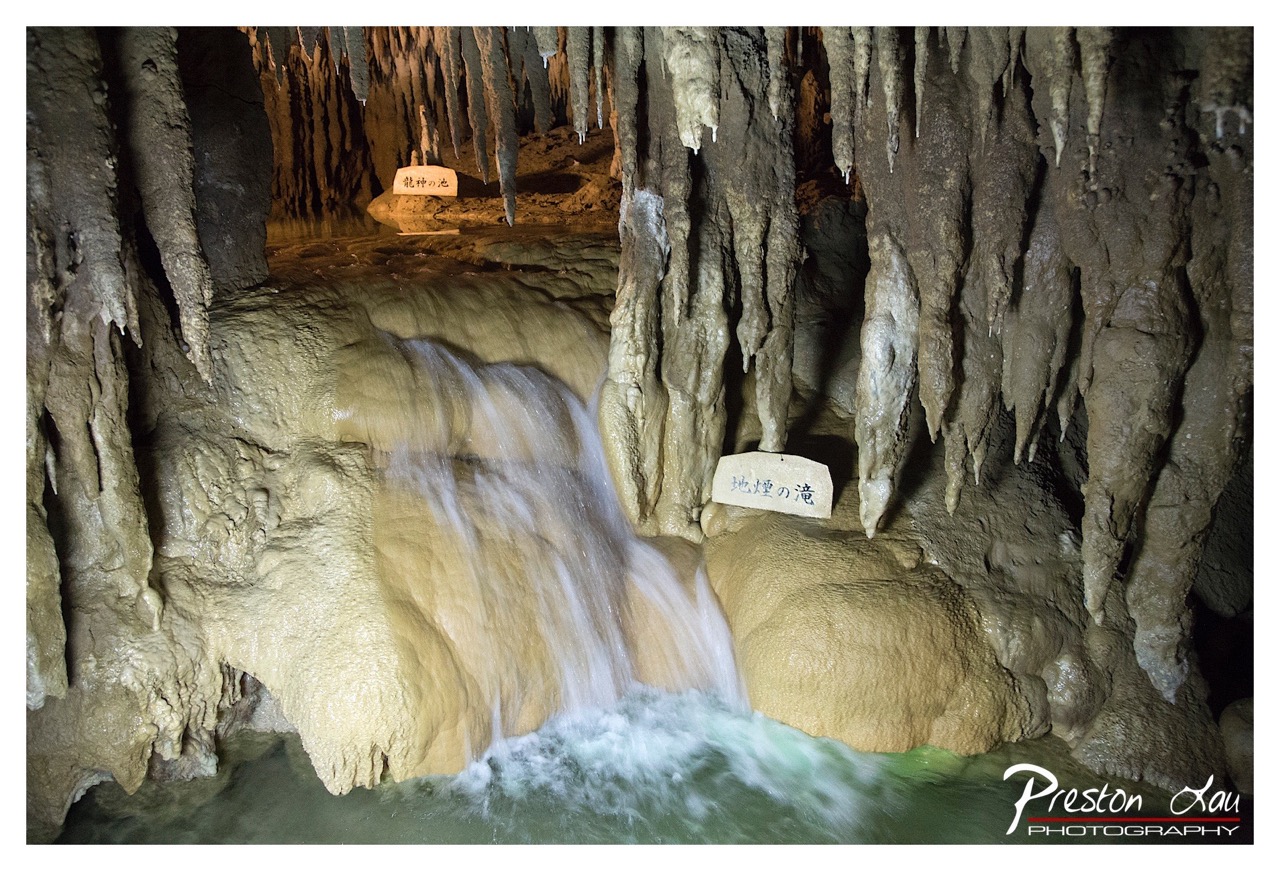

Cave Explorer's Flowstone Folly
Subject Rating: 7/10
Welcome to the geological equivalent of a spa, complete with calcium carbonate facials! This shot captures a dramatic scene inside a cave, where a waterfall cascades down a multi-textured rock formation into a shimmering pool below. What's happening is a timeless process of water erosion and mineral deposition, creating flowstone and stalactites that hang like ancient, muddy icicles from the unseen ceiling. The mood is one of mysterious subterranean beauty, slightly disrupted by the rather practical placement of signs, presumably labeling these magnificent formations in Japanese. It's a classic cave setup: dripping rocks, flowing water, and the subtle glow of artificial lighting highlighting the textures of geological time.
From a photographic standpoint, this image is a testament to the challenges and rewards of cave photography. The composition effectively places the dynamic flow of water as the central element, leading the eye down into the greenish pool. The earthy tones of the rock dominate, complemented by the cool blues and whites of the water, achieving a pleasing, if limited, color palette appropriate for the setting. The lighting, likely a mix of fixed cave lights, highlights the textures beautifully but can be tricky to expose for – kudos to the photographer for balancing the bright water with the darker rock. The long exposure used to blur the water is a standard, effective technique, giving the fall a silky, ethereal appearance. The only real photographic faux pas, albeit likely unavoidable in a public show cave, is the presence of the signs, which add a touch of human intrusion that breaks the spell of pure, untouched nature. "Beware of the beautiful waterfall," perhaps? Or maybe "This stalactite is sponsored by... calcium"? Either way, capturing such detail and movement in the low light of a cave requires patience and technical skill.
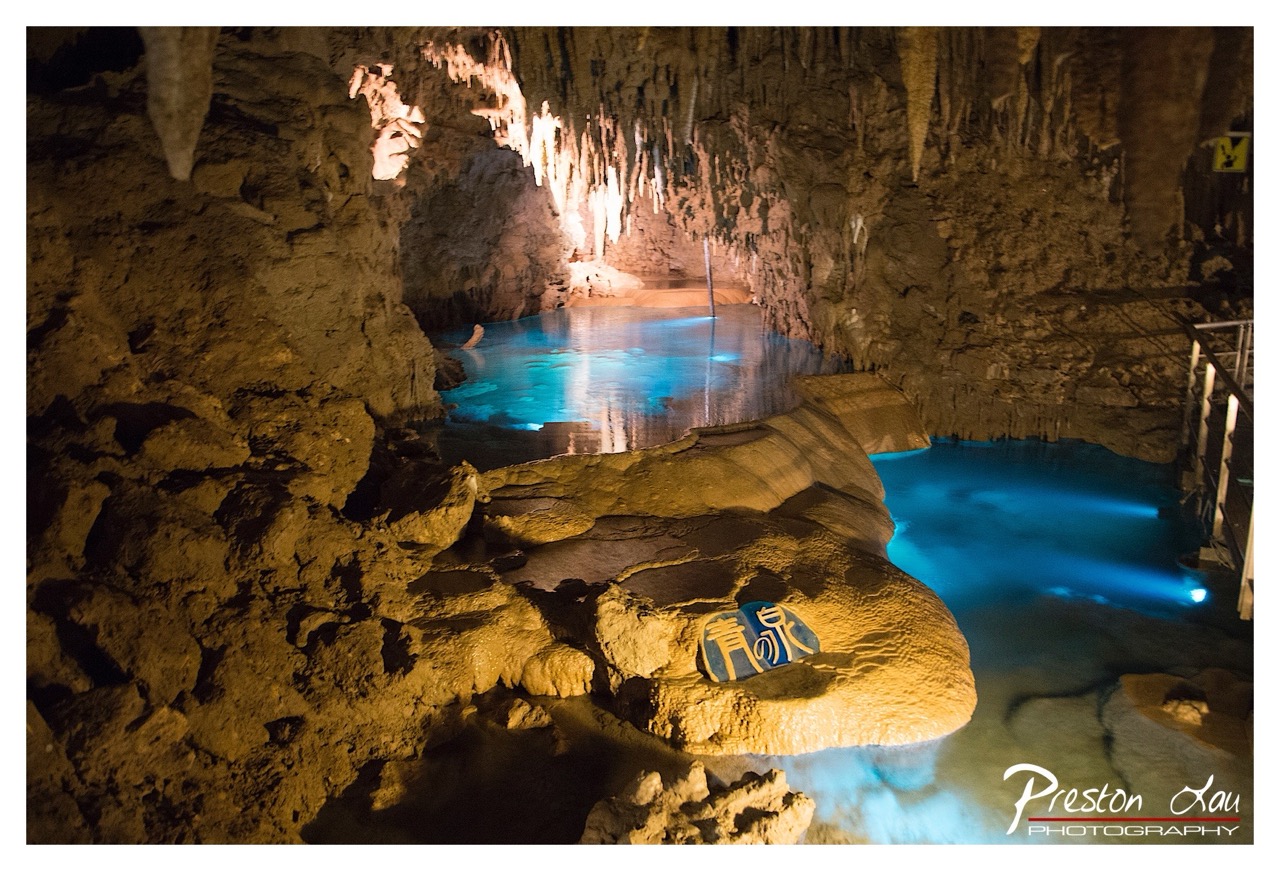

The Blue Grotto's Disco Ball
Rating: 8/10
Ah, the classic "cave with eerily glowing blue water" shot! The subject here is a subterranean pool bathed in artificial blue light, nestled amongst ancient rock formations and dripping stalactites. It looks like someone decided this natural wonder wasn't quite *extra* enough and decided to install some dramatic underwater rave lighting. What's happening is we're peering into a mysterious, serene (if you ignore the potentially questionable light source) part of a cave system, possibly a popular tourist spot given the hint of a walkway on the right and the sign on the rock, which appears to read something about a "Blue Spring" or "Blue Fountain" – fitting! The mood is certainly atmospheric, leaning towards mystical or even slightly otherworldly, though the vibrant blue pushes it into almost surreal territory. It captures a common style of showcasing show caves, focusing on the unique features enhanced by artificial means.
From a photographic standpoint, tackling the low light and high contrast here is always a challenge. The composition uses the foreground rocks effectively to frame the vibrant pool and create a sense of depth leading into the cave's interior. Lighting is, well, the star here – that intense blue is definitely eye-catching, though it completely dictates the color palette and likely required some careful white balance decisions (or maybe embracing the funkiness!). The warm tones of the rock provide a nice contrast to the cool blue, preventing the scene from becoming monochromatic. The subject matter itself is inherently interesting, combining geology and the allure of hidden water sources, even if the blue light feels a bit *much* sometimes. The watermark from Preston Lau Photography is clearly visible, branding this particular moment of subterranean luminescence. Overall, a successful capture of a visually striking, if slightly over-the-top, natural-turned-unnatural wonder.
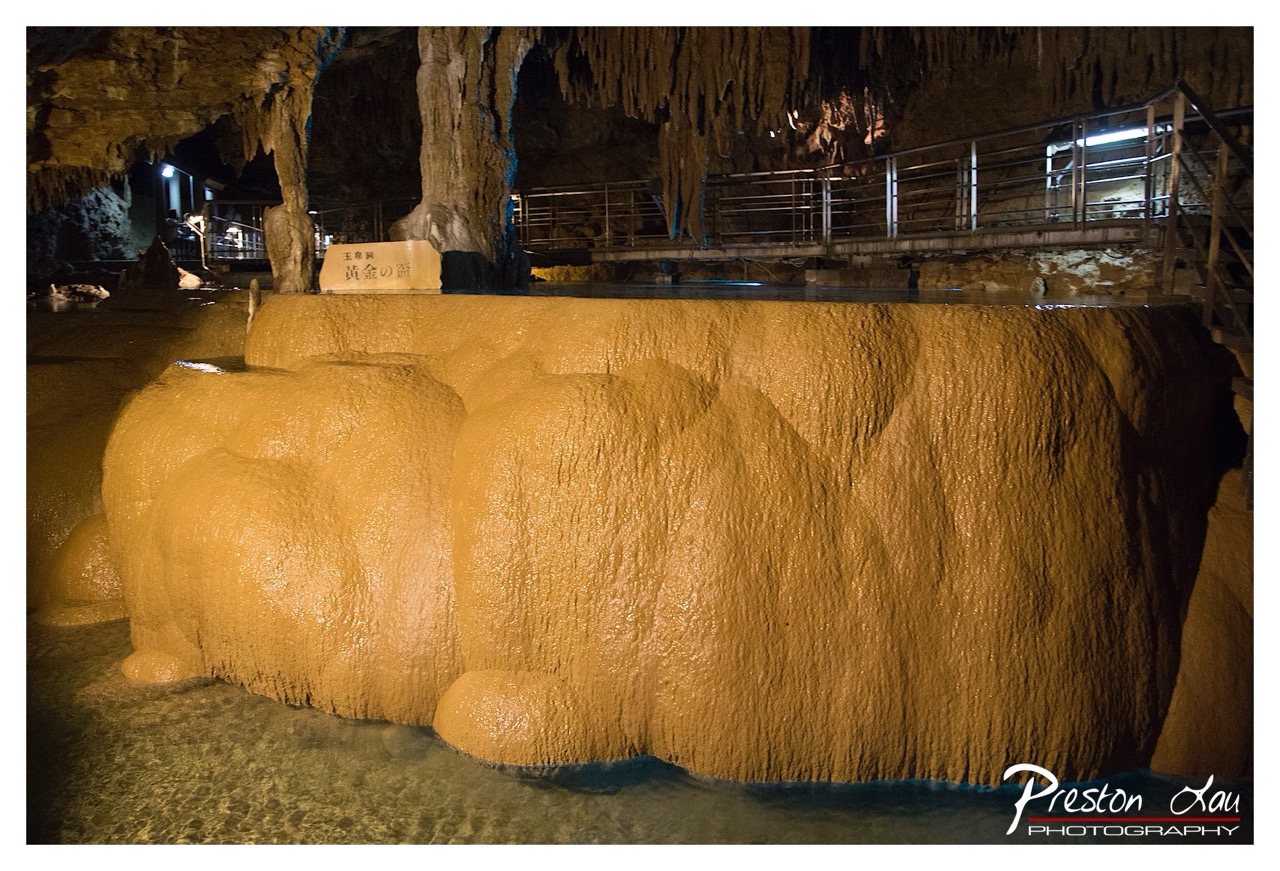

Gyokusendo Cave's Golden Cup
Rating: 7/10
Deep within what appears to be Japan's famous Gyokusendo Cave, we find this magnificent 'Golden Cup' formation, which looks less like a cup and more like a giant, petrified blob of something delicious, maybe a melted caramel sculpture or a very old, very large scoop of peanut butter ice cream that defied gravity. The image captures the formidable scale and intriguing texture of this unique cave deposit, likely a type of flowstone, rising impressively from a pool of water. The mood is one of ancient wonder mixed with the slight artificiality of being a well-lit tourist attraction, complete with a railing and walkway visible in the background, reminding us that even the deepest wonders aren't safe from accessibility ramps. The presence of the sign, helpfully identifying our colossal caramel conundrum, adds a touch of the mundane to the sublime.
From a photographic standpoint, tackling the low light of a cave is always a challenge, and here, the artificial lighting does its job, illuminating the formation's intricate, drippy texture effectively. However, the lighting is quite directional, leading to harsh highlights and deep shadows, which emphasize the contours but perhaps flatten the overall depth. Compositionally, the formation dominates the foreground, which is appropriate given it's the main subject, but it feels slightly cut off at the top, leaving us wanting to see its full height. The inclusion of the water in the foreground adds a nice reflective surface and cools down the predominantly warm color palette of the stone, creating a subtle contrast. The background, showing the walkway and the dark, mysterious cave ceiling adorned with stalactites, provides essential context and a sense of scale, highlighting just how grand this underground environment is, even if the railing feels a bit like a necessary evil for safety (and ruins the 'undiscovered' fantasy). Overall, it's a solid shot showcasing an impressive natural formation, but the typical challenges of cave photography – especially lighting and potentially awkward compositions necessitated by the environment – are apparent.
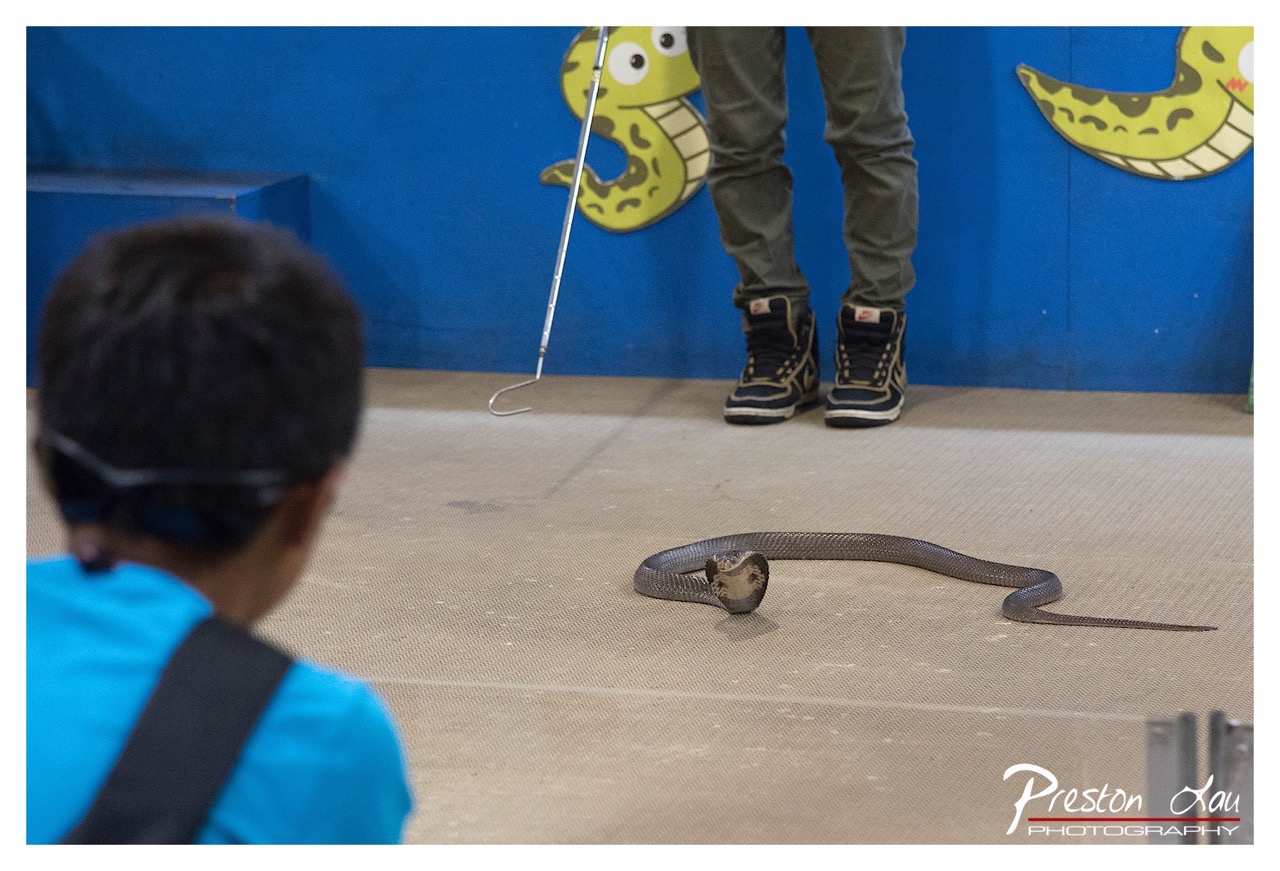

Cobra Kai Do, But With Less Kicking, More Slithering
Subject Rating: 8/10 (For the inherently captivating nature of a large snake).
Welcome to the slithering spectacle! This shot perfectly captures the intense moment during a snake demonstration, focusing squarely (well, sort of squarely) on a rather magnificent cobra poised on the floor. What's happening is a classic encounter: a performer, visible only by their legs and trusty snake hook in the background, interacts with the star reptile, while a young audience member in the foreground, conveniently out of focus, provides a sense of scale and perspective – or perhaps just blocks the view slightly, depending on your opinion of foreground elements. The mood is undeniably tense and intriguing, amplified by the contrast between the real, formidable snake and the cheerfully innocent cartoon snake illustrations adorning the blue wall behind. The subject, the cobra itself, is undeniably captivating, earning a solid 8/10 purely based on its cool factor and inherent photogenicity, even if it wasn't posing for its headshot.
From a photographic standpoint, this image is a delightful blend of candid capture and compositional conundrums. The shallow depth of field successfully isolates the cobra and the handler's feet, drawing the eye to the central action, but the out-of-focus child in the foreground, while adding a human element and demonstrating the audience's engagement, creates a significant visual obstruction. It feels like the photographer was capturing the moment from their vantage point, perhaps stuck behind someone. The lighting is even and functional, typical of an indoor event, preventing harsh shadows but lacking dramatic punch. The composition, while potentially frustrating for a catalogue shot needing a clear view, tells a story of 'being there', capturing the slightly chaotic reality of event photography where you work with the view you're given. The choice to shoot low enhances the snake's presence, making it appear larger and more dominant within the frame. It's a shot that tells a story of observation and performance, even if the composition is a bit... *wild*.
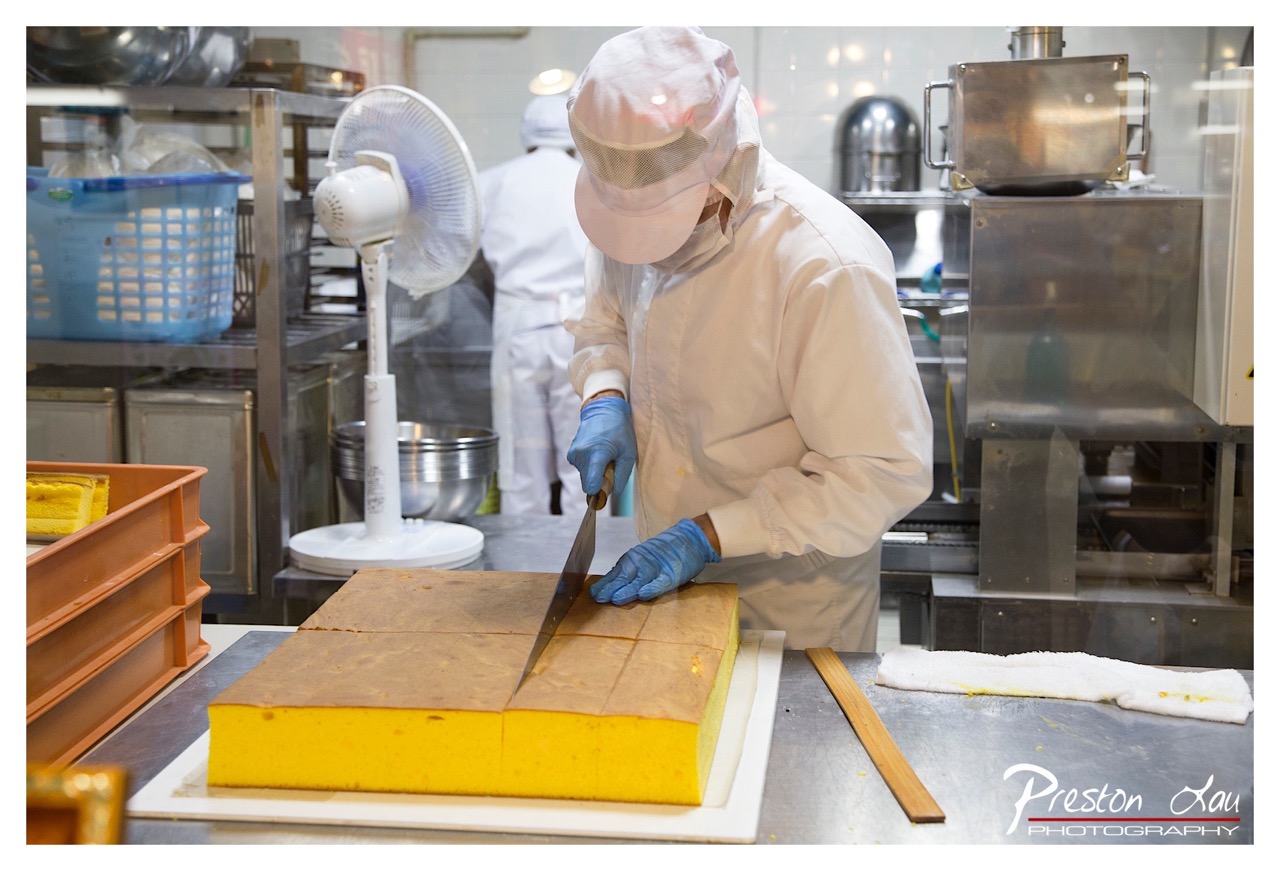

The Great Cake Division
(8/10) Our subject, clad in the standard-issue uniform of a large-scale bakery – a white lab coat, cap, and fetching blue gloves – is engaged in the meticulous task of slicing a colossal sheet cake. This isn't just any cake; it's a golden, fluffy monolith, pre-scored with guide lines, undergoing precise division into perfect squares. The mood is one of focused, almost clinical, efficiency. The baker wields a long, sharp knife with expert care, creating clean lines in the dense sponge. In the foreground, the already-cut portions sit ready, while in the background, a bustling commercial kitchen environment unfolds with towering metal shelves, industrial machinery, and even a floor fan bravely battling the heat, all bathed in bright, even lighting typical of a workspace designed for visibility, not ambiance.
This image functions as a documentary snapshot of industrial baking. Compositionally, the main action is positioned slightly off-center, giving a sense of the surrounding workspace, which is a maze of stainless steel, plastic crates, and various equipment. The lighting is flat but effective, ensuring every cut and texture of the cake is clearly visible, perhaps sacrificing artistic shadow play for practical clarity. The color palette is dominated by the warm yellow of the cake and the cool whites and blues of the worker and kitchen hardware, creating a clean, almost sterile contrast that hints at hygiene standards. The shallow depth of field keeps the focus squarely on the slicing, blurring the busy background into a supporting cast of factory elements. It’s a peek behind the curtain, showing the scale and precision required to produce baked goods in quantity, making you appreciate the journey from giant slab to individual slice.


Title: Glassy-Eyed Shopper Contemplating Ryukyu Crafts
Rating: 7/10
This photograph captures a moment of retail contemplation, featuring a young person from the back, head cocked slightly, gazing intently at a vibrant display of colorful glass items. The subject rating of 7 reflects the visually appealing nature of the glasswork itself, although the primary subject's obscured face makes a strong connection difficult. What's happening is a classic scene: a potential customer browsing potential purchases. The mood is curious and perhaps a bit overwhelmed, given the sheer variety on offer, while the overall tone leans towards a documentary snapshot of a tourist experience in what is likely a Japanese setting, judging by the extensive signage in Japanese characters. Pertinent objects abound, from the myriad blue, red, yellow, and clear glass cups, jugs, and bowls on the shelves to the large informational signs detailing the different styles ("Clear glass," "Bubble glass," "Grains Fritt," "Original") and presumably the costs and time involved in making them.
From a photography perspective, the composition places the anonymous shopper strategically in the foreground, adding a human element and guiding the eye toward the main display. However, the framing is a bit tight, cutting off the bottom of the display table. Lighting appears to be natural, likely from the open-air structure, creating reflections on the glass which adds sparkle but also occasional glare. The colors are the standout feature – the vibrant blues, reds, and yellows of the glass pop against the more muted background, though the white balance might be slightly off, lending a warm cast to the scene. The background reveals a bustling environment with other people and the open-sided nature of the building, suggesting a workshop or market. While the image is a decent record of the scene, a slightly wider angle to capture the full display or a different perspective might have elevated the composition further. The text "Preston Lau PHOTOGRAPHY" watermark is a prominent addition, staking claim to this moment of indecision in the world of beautiful, breakable things.
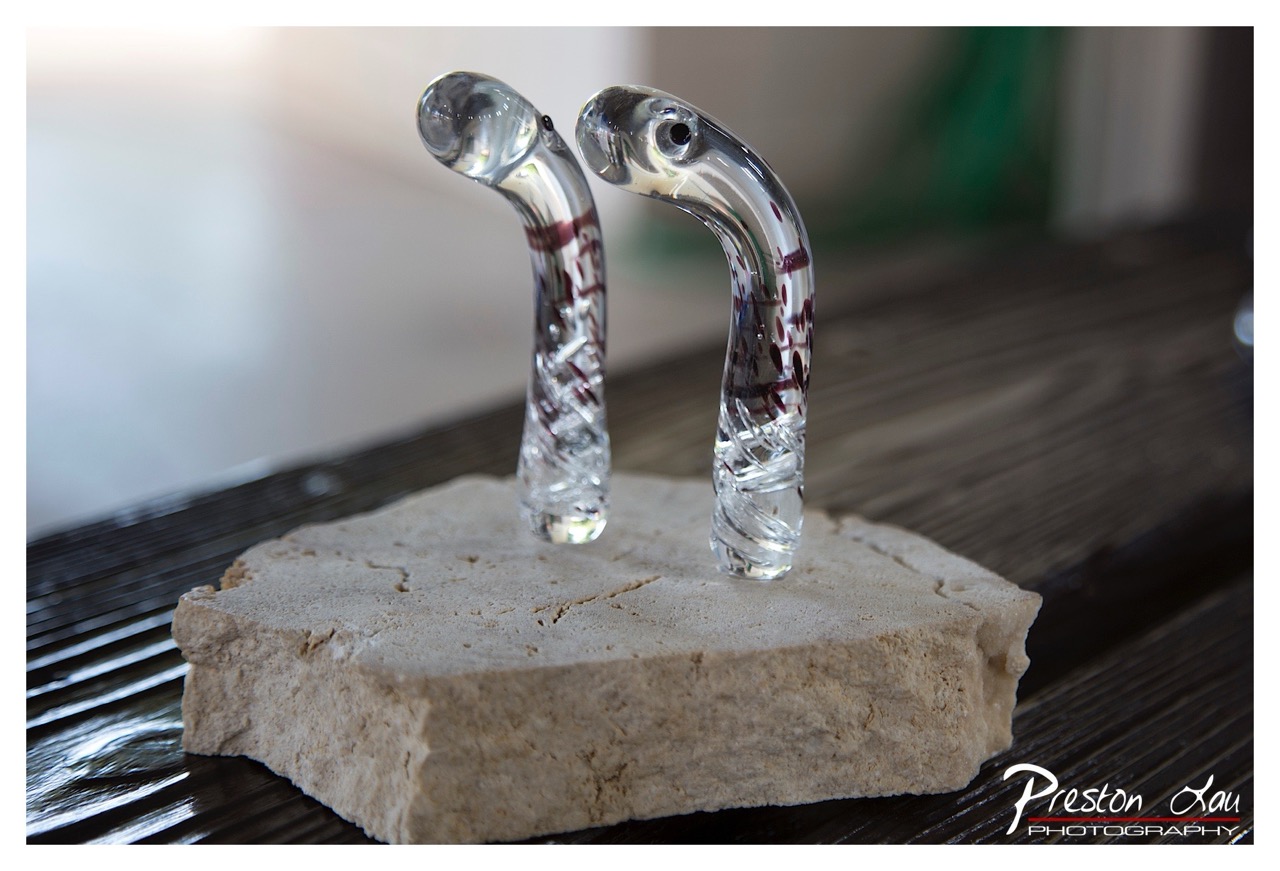

Abstract Glass Curios
Rating: 7/10
Here we have two rather peculiar glass objects, resembling futuristic walking canes for garden gnomes or perhaps highly decorative hooks designed by a jellyfish. They stand upright on a rough-hewn block of light-colored stone, looking as though they've just materialized from a portal and are pondering their next move. The scene is set on what appears to be a dark wooden surface with prominent horizontal lines, adding a grounding texture beneath the otherworldly subjects. The mood is calm and focused, drawing the viewer's eye directly to the intricate details within the transparent forms and the tactile surface of the stone, while the background fades into a soft, nondescript blur of light and subtle color.
From a photographic perspective, this shot utilizes a shallow depth of field effectively to isolate the subjects on their rocky perch, making the background a painterly wash that doesn't distract. The composition places the objects slightly off-center, adding a touch of dynamic balance. The lighting is excellent, highlighting the reflective qualities of the glass, revealing the swirling patterns and internal specks of maroon or deep red, and adding definition to the stone's texture. The choice of a simple, textured base like the stone is a good contrast to the smooth, complex glass, although one might wonder if a different surface could have enhanced the abstract nature even further. Overall, it's a well-executed macro-style shot that successfully focuses on the unique form and material of these intriguing glass sculptures, leaving you to ponder their purpose, or just admire the skill involved in capturing their luminous transparency. The inclusion of the photographer's watermark is a standard touch for showcasing portfolio work.
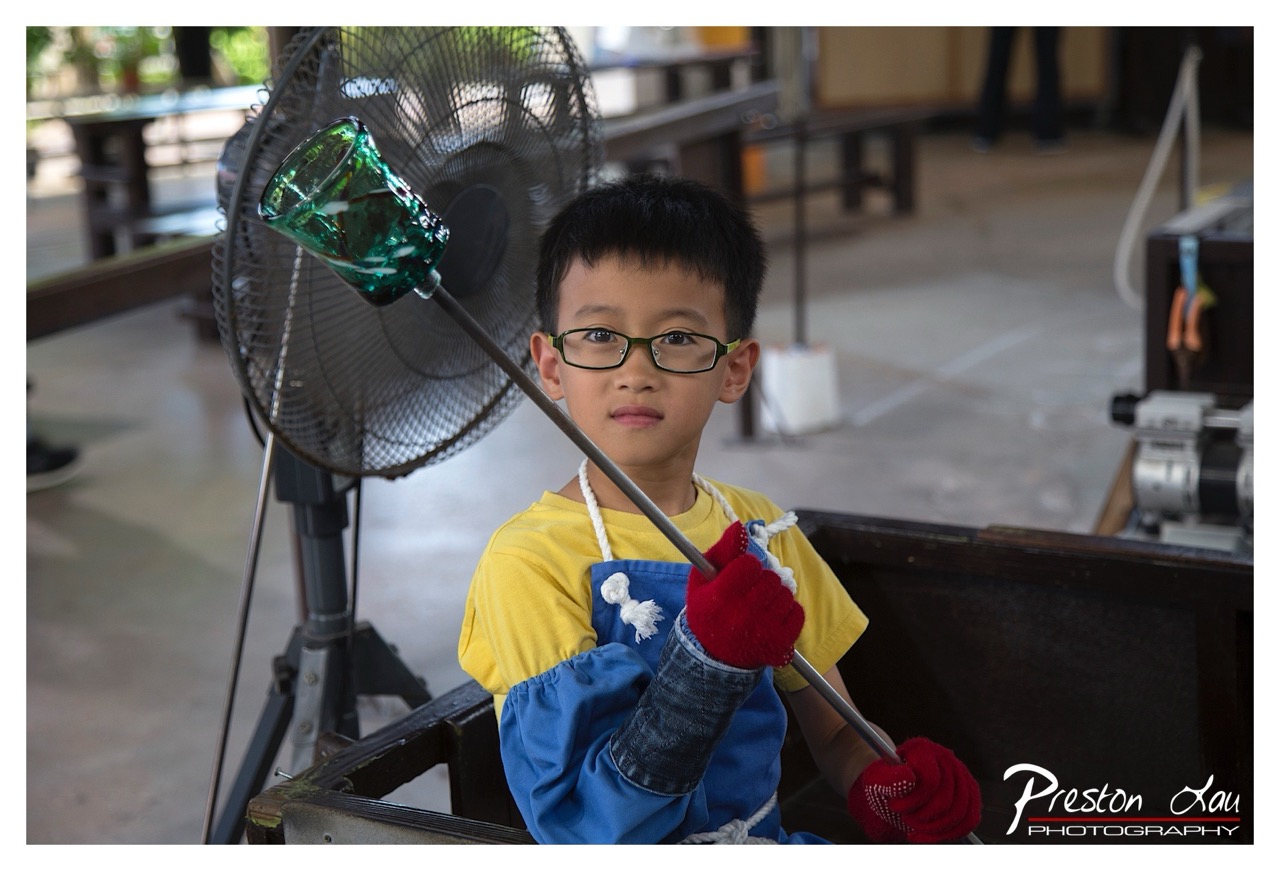

Young Artisan Under the Fan's Gaze
Rating: Subject 8/10
This photograph captures a young boy, wearing glasses and bright protective gear, intently focused on a glassblowing activity. He holds a metal rod with a glowing green glass piece attached at the end, positioned near a large industrial fan, presumably to aid in cooling or ventilation. The mood is one of serious concentration and perhaps a touch of nervous excitement as he navigates the delicate process. Key objects include the boy's red protective gloves, blue and yellow apron, his glasses, the glassblowing tool, the green glass form, and the imposing fan behind him. The background shows a workshop or studio setting, with blurry benches, equipment, and what looks like other people in the distance, suggesting this is a public demonstration or class.
From a photography perspective, the composition places the boy slightly off-center, with the glass piece and tool creating a strong diagonal line that draws the eye. The depth of field is shallow, effectively blurring the background and isolating the subject, though the large fan blades behind the green glass are a slight visual distraction, almost competing for attention. Lighting appears to be a mix of ambient light, providing a relatively soft illumination on the boy's face, highlighting his serious expression. The vibrant colors of his outfit and the glass contrast well with the more subdued background, making the subject pop. While the framing feels a little tight on the right, slightly cutting off the edge of the wooden trough, it keeps the focus squarely on the boy and his task. The photographer, Preston Lau, has also included their watermark prominently in the lower right corner, a common practice to protect their work. Overall, it's a well-executed shot capturing a moment of focused learning, even if the giant fan looks ready to blow his masterpiece away!
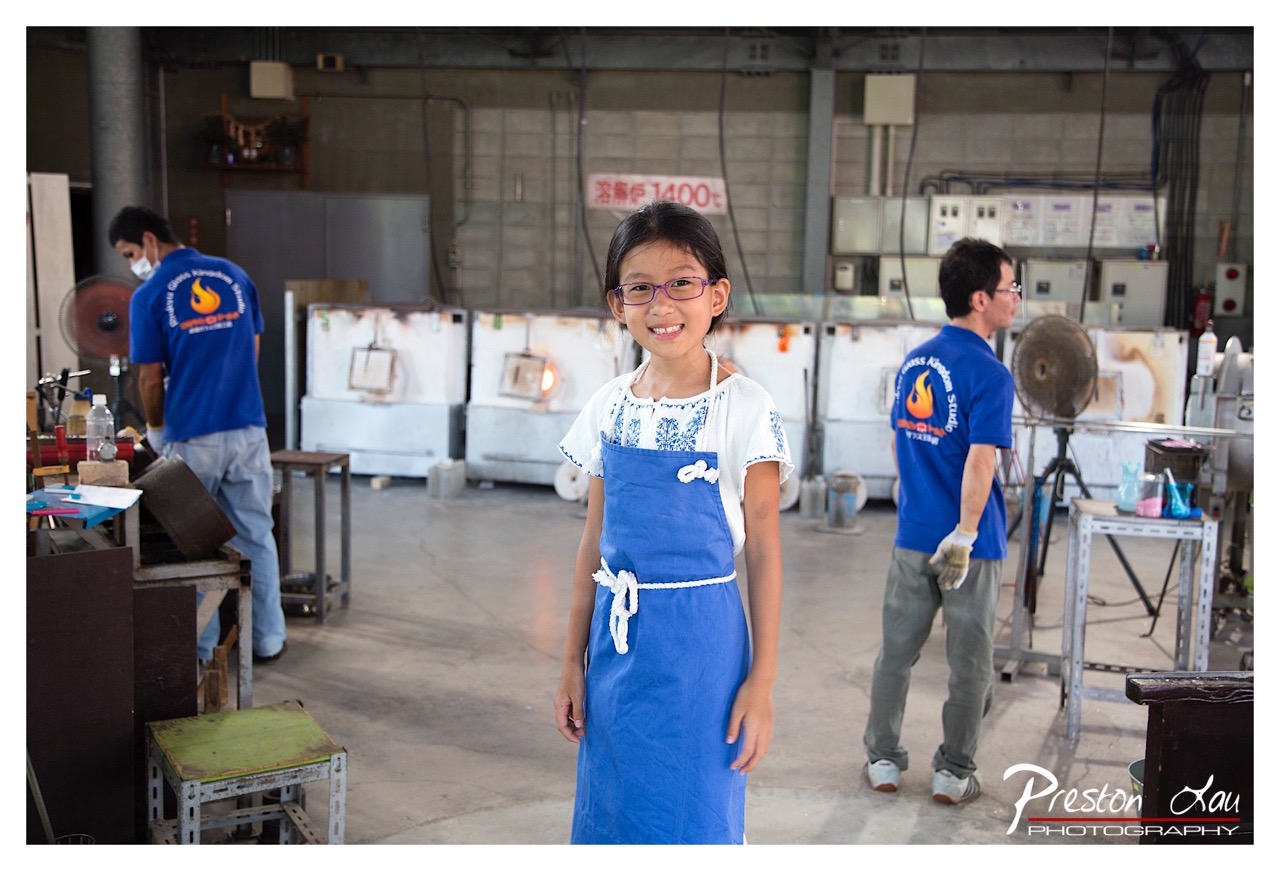

Ready for the Inferno!
Subject Rating: 9/10
Strike a pose! Here we have a wonderfully captured moment featuring a young enthusiast, sporting a perfectly fitted blue apron and stylish purple glasses, beaming with pride in what appears to be a bustling glassblowing studio. Her smile is absolutely infectious, rating a solid 9 out of 10 for sheer photographic subject charm and willingness to engage the camera. She stands front and center, the undeniable star of the show, seemingly poised to create her own molten masterpiece or perhaps just finished one. The mood is bright and cheerful, a lovely contrast to the potential intensity and heat implied by the industrial setting. It's a portrait that speaks of excitement and participation, capturing the joy of a new experience.
Behind our young protagonist unfolds the authentic scene of a working studio. Multiple large furnaces, some glowing ominously, line the background, providing context and scale to the craft. We see glimpses of actual glassworkers in blue shirts, one busy on the left and another standing to the right, adding dynamic elements and reinforcing the active nature of the environment, though they are definitely relegated to supporting cast roles in this shot. The composition places the girl slightly off-center, using the depth of the workshop to create a sense of place. Lighting is reasonably even on her face, though managing the bright spots from the furnaces in the background likely presented a challenge. The overall color palette is dominated by the blues and grays of the studio and uniforms, making the girl's bright white shirt and vibrant personality pop. Despite some foreground clutter that could be cropped, the focus is sharp on our smiling subject, cementing this as a lively, documentary-style portrait with a clear emphasis on personality.
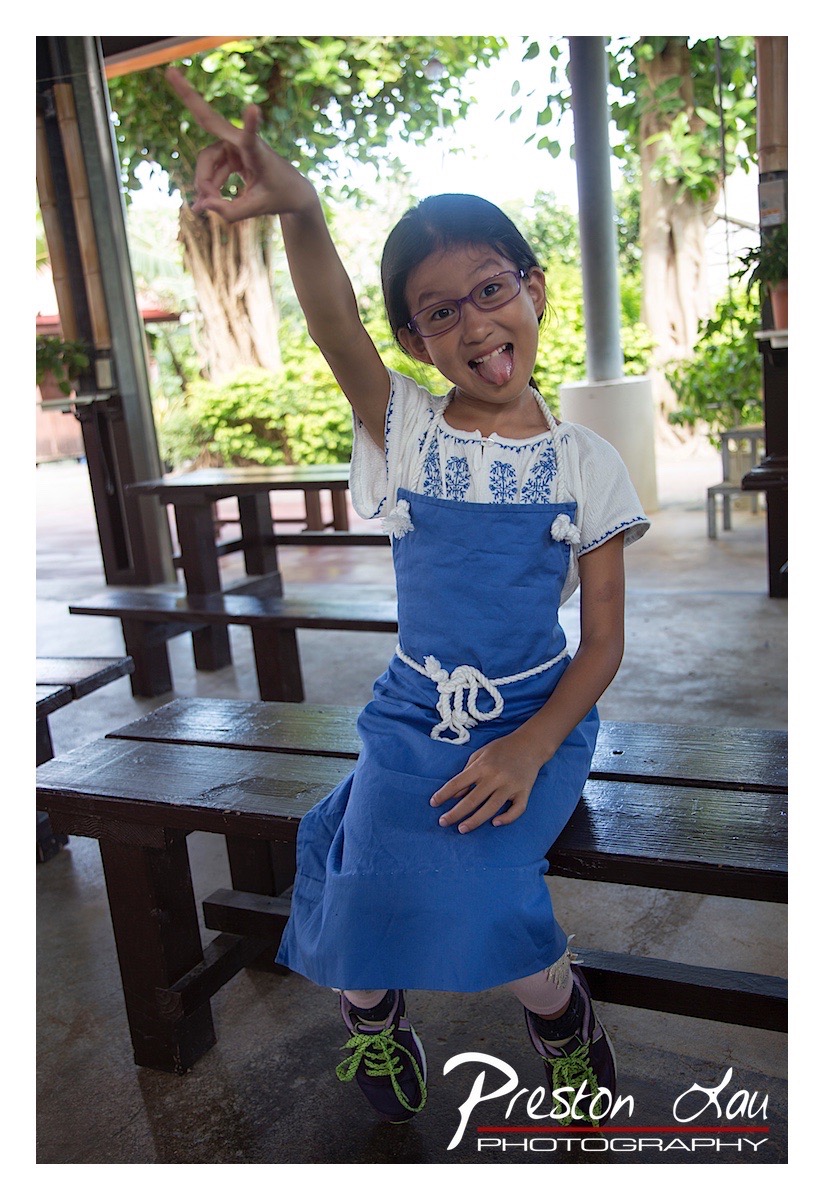

Title: The Tongue-Tied Philosopher of the Bench
Rating: 8/10
Well, hello there, tiny human of great expression! Our subject, a young girl radiating pure, unadulterated silliness (and a solid 8/10 for sheer personality), is caught mid-protest or perhaps mid-profound thought, sticking her tongue out with gusto and flashing a mysterious hand gesture. Is she signalling "okay"? Is she crossing her fingers for good luck? Or is she simply telling the camera exactly what she thinks of this photo session? Seated on a sturdy wooden bench in what appears to be an outdoor seating area – complete with heavy wooden furniture, concrete floor, and a backdrop of lush, blurred greenery – she commands the frame with her playful defiance. Her purple glasses add a touch of scholarly mischief to her look, perfectly complementing the blue apron-style dress cinched with a quirky white rope, worn over a white embroidered top that suggests either folk art enthusiast or someone who just raided their grandma's closet (in the best way possible). The mood is undeniably light, chaotic, and wonderfully human.
From a photographic perspective, the composition uses the strong lines of the benches to ground the image, though placing the subject slightly off-center keeps it from being too static. The natural light, likely from an overcast sky or shaded area, provides soft illumination, avoiding harsh shadows on the face, which is a win, though a little pop of fill light might have made those eyes sparkle even more behind the glasses. The colors are natural and pleasing, with the bright blue dress and green shoelaces providing nice focal points against the earthy tones of the wood and concrete. The background blur (bokeh) does a decent job of separating the subject, though the structure and distant trees are still quite recognizable, giving context without being overly distracting, save perhaps for the prominent pillars. And then there's the watermark, which, while understandable for a photographer, takes up a significant chunk of real estate at the bottom, drawing the eye away from the main event – the girl's glorious, tongue-out expression. Still, it's a well-captured moment of childhood energy and character.
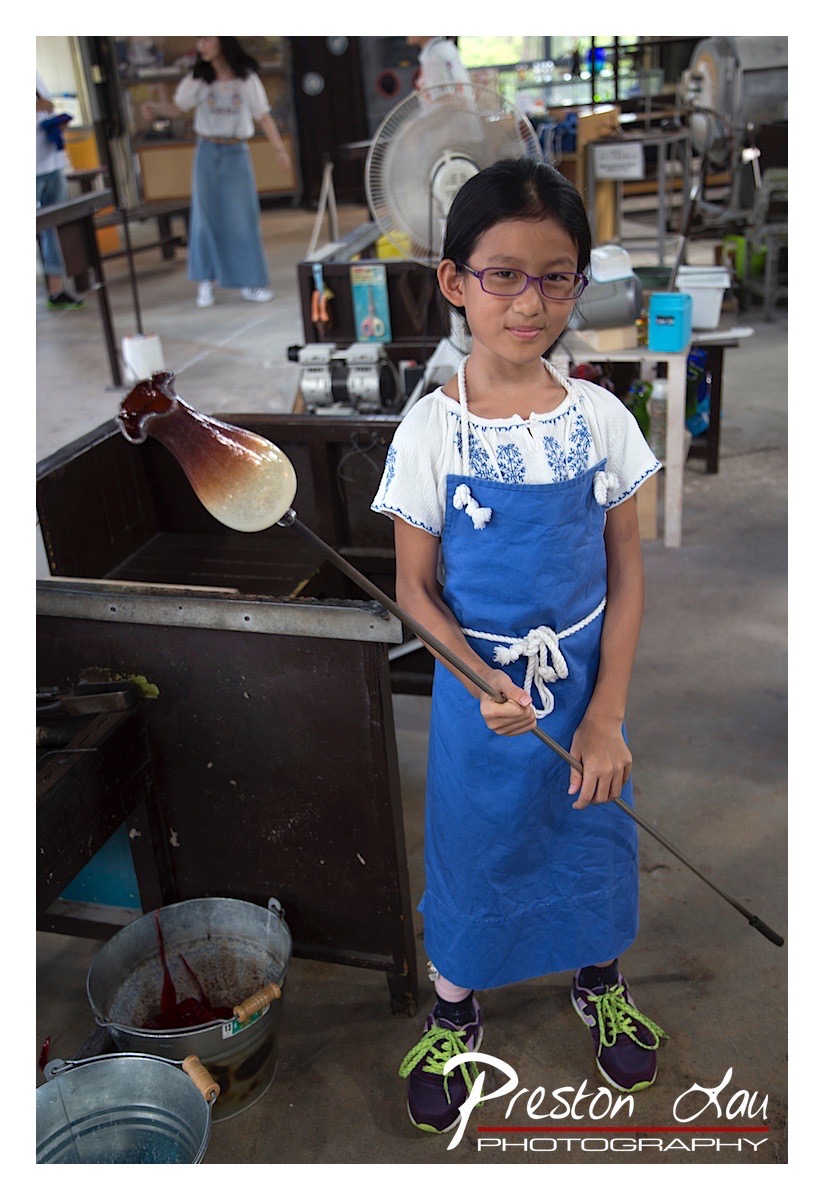

Glassblowing Prodigy in Training
Rating: 9/10
Here we have a young aspiring artisan bravely taking on the fiery art of glassblowing. Our determined subject, complete with protective blue apron and intensely focused gaze, is clutching a punty rod with a glowing blob of molten glass attached, ready to shape it into... well, maybe a slightly wobbly vase or a very unique paperweight. The mood is one of serious concentration mixed with the inherent excitement of working with something that hot and malleable. It looks like a hands-on workshop experience, possibly aimed at introducing kids to traditional crafts, which is fantastic, even if the stakes (and temperatures) seem pretty high for someone so small. The buckets of liquid nearby add a touch of realistic messiness – this isn't a clean hobby!
From a photographic perspective, the composition works well, placing the subject and the intriguing piece of hot glass front and center, creating a diagonal visual line with the rod. The lighting is functional, highlighting the vibrant, glowing glass against the more muted workshop tones, although slightly more directed light on the subject's face might have enhanced the portrait aspect. The colors are dominated by the strong blue of the apron and the fiery red/orange/white gradient of the glass, contrasting nicely with the industrial grays and browns of the background. The slightly cluttered workshop background, complete with a large fan and other equipment, provides authentic context for the activity. It's a documentary style shot capturing a moment of intense engagement, proving that even at a young age, facing down molten materials requires serious dedication (and probably safety goggles, though hers look more like standard glasses).
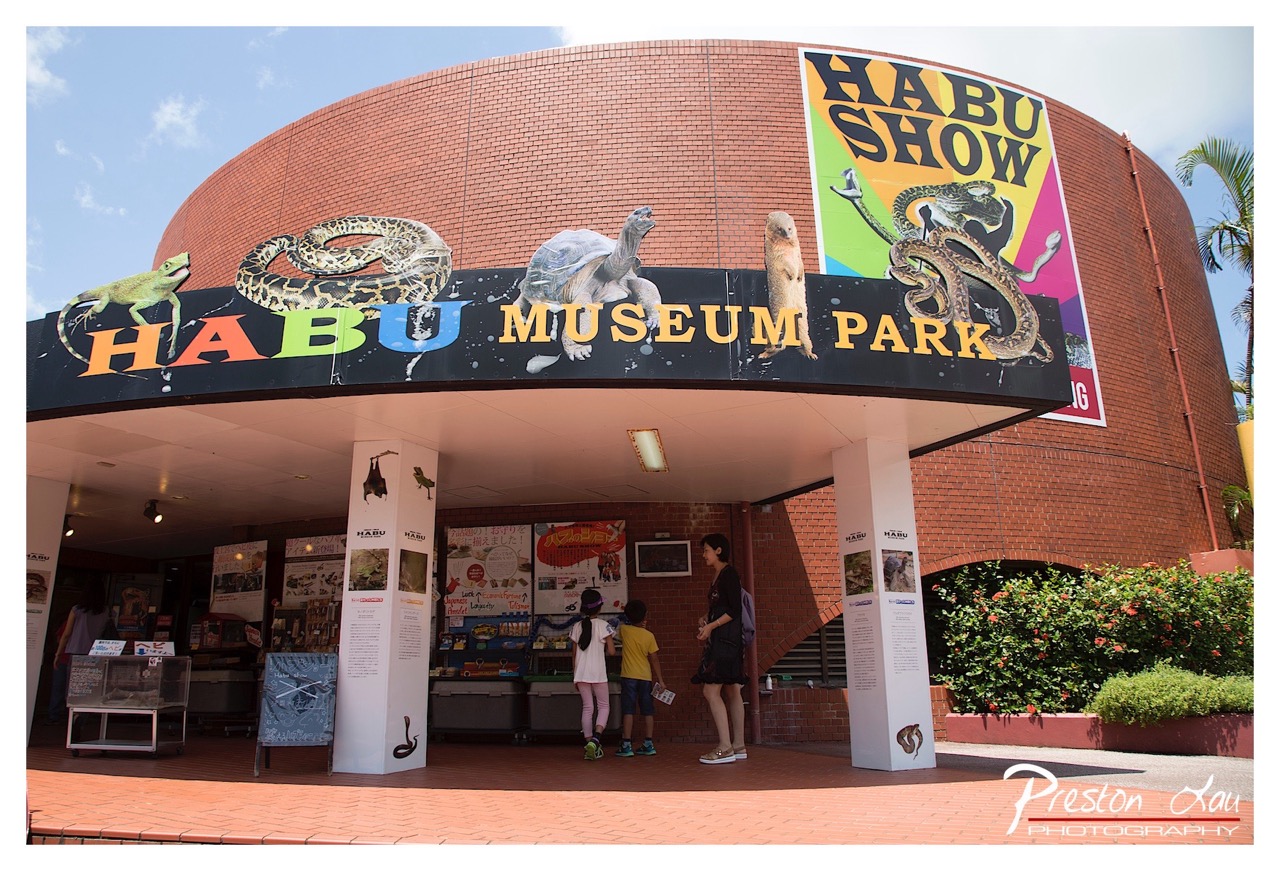

Habu Museum Park Entrance
Subject Rating: 7/10
Welcome to the Habu Museum Park! This photo captures the slightly eccentric entrance of a building dedicated to the habu, a venomous snake, and other creatures, judging by the enormous, slightly terrifying animal figures plastered across the front. We see a giant python coiled around the letter 'A', a rather chill-looking tortoise, a watchful mongoose, and on a separate banner for the 'Habu Show', a mongoose locked in eternal combat with a cobra, or perhaps just striking a dramatic pose. Below the vibrant, animal-laden sign, a family is pausing near the entrance, perhaps contemplating the thrilling (or chilling) wildlife encounters that await inside. The scene feels typical of a tourist spot, promising a unique local experience, likely involving reptiles and maybe some educational displays about why you shouldn't step on the local wildlife.
From a photography perspective, this is a classic grab shot of a landmark, capturing the essence of the location in bright, unfiltered daylight. The composition is straightforward, centering the building's facade and the prominent sign, which admittedly steals the show with its larger-than-life characters. The harsh midday sun creates strong shadows but also makes the bright colors of the sign pop against the warm brickwork. It effectively documents the scene and gives a clear idea of what the place is about – reptiles and, apparently, dramatic showdowns between predators and prey. While perhaps not a masterclass in artistic lighting or complex composition, it serves its purpose perfectly: a memorable record of visiting a place where giant snake statues guard the door.
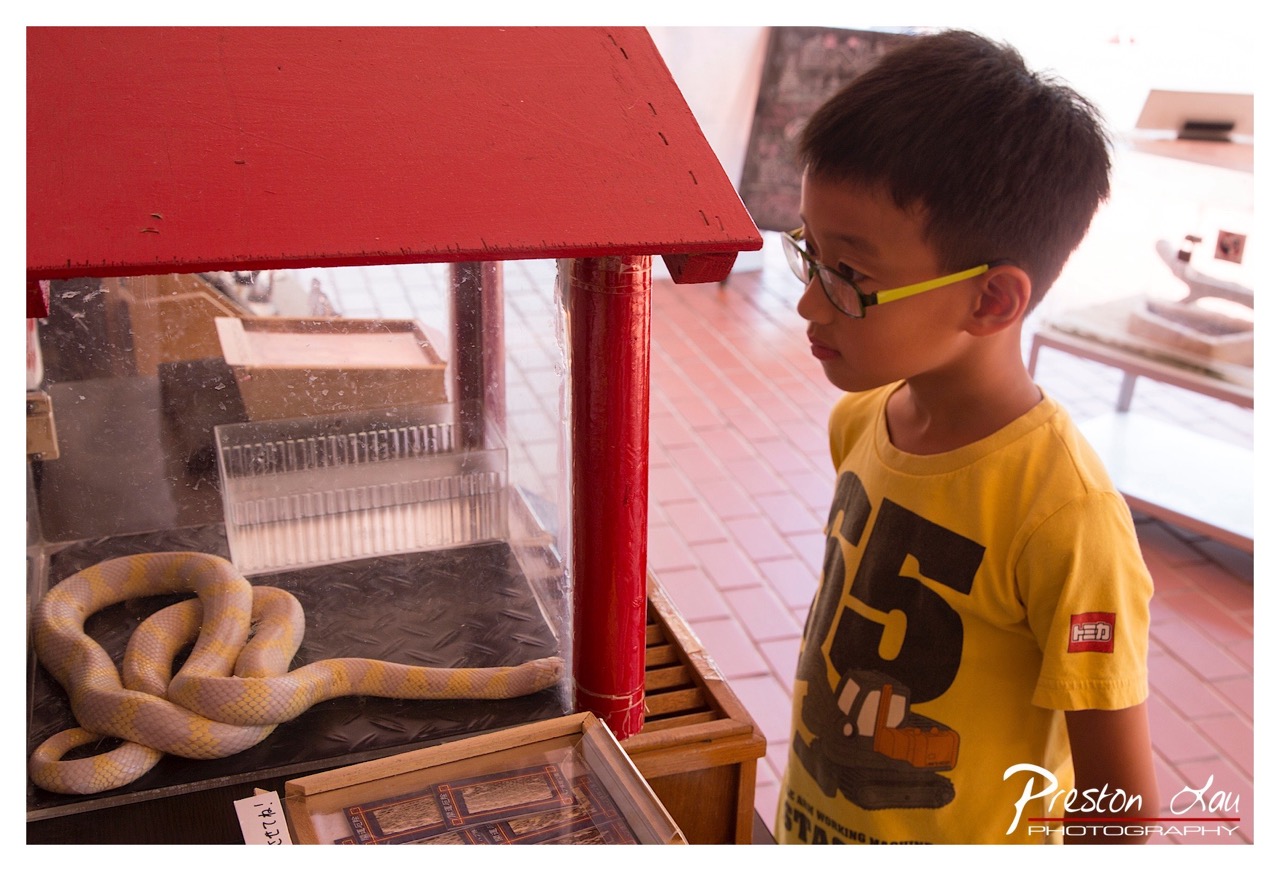

Title: Curiosity Meets Serpent
Subject Rating: 7/10 (for the snake's photogenic coil)
This captivating shot perfectly captures a moment of intense, youthful curiosity. A young boy, sporting bright yellow-rimmed glasses and an equally bright yellow shirt featuring some sort of heavy machinery graphic, is utterly engrossed in observing a coiled snake. The serpent, a pale creature with distinct yellow/grey patterns, lies calmly in a glass display case, oblivious to the boy's focused gaze. The setting appears to be an indoor or semi-outdoor educational space, possibly a museum or exhibit, indicated by the tiled floor and blurred structures in the background. A striking red structure with a red pole serves as a bold frame or divider, separating the boy's world from the snake's enclosed habitat. Wooden elements in the foreground, one displaying small images or cards, hint at additional information or context for the exhibit.
From a photographic standpoint, the composition cleverly uses the red structure as a strong vertical and horizontal element to section the frame, placing the boy on the right and the snake on the left, creating a visual dialogue between observer and observed. The lighting is natural and warm, highlighting the boy's profile and the snake's patterned scales, although the glass case inevitably introduces some reflections – a common, and sometimes frustrating, challenge when photographing behind barriers. The shallow depth of field effectively isolates the main subjects from the somewhat busy background, drawing the viewer's eye directly to the interaction. While the boy's face is in profile, his furrowed brow and intense stare convey the depth of his interest, making this a compelling candid moment despite the posed-like subject (the snake). It's a classic capture of a child's encounter with the wonders (and mild apprehension) of the natural world, framed by the constraints of exhibition.
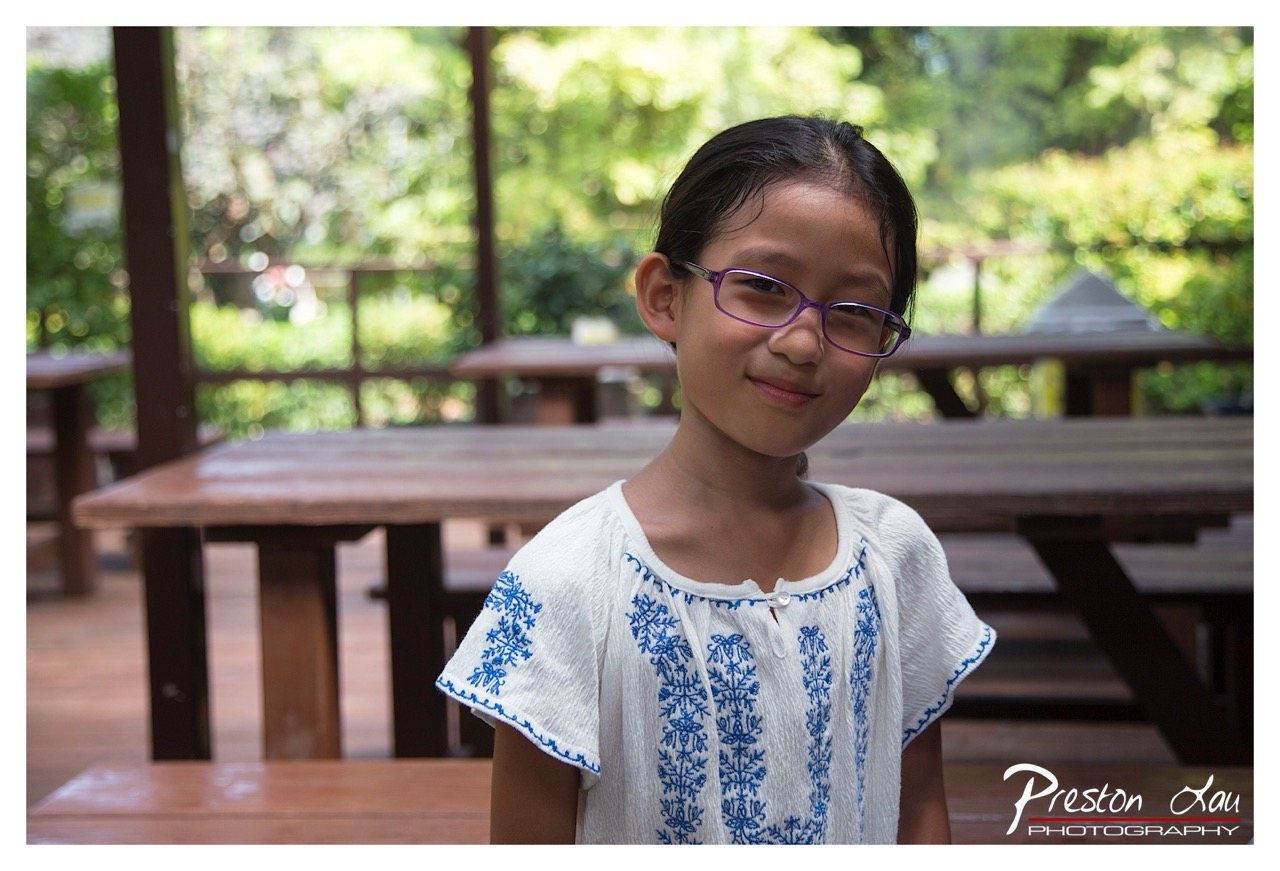

A Winking Welcome
Subject: 9/10
Okay, check it out, we've got a charismatic kiddo here, giving us the ol' wink-and-smile combo. Clearly, she's either sharing a top-secret popsicle location or just knows she's photogenic. She's sporting some snazzy purple glasses and a cool white shirt with intricate blue embroidery that adds a nice splash of color. She's seated among a maze of sturdy wooden tables, probably plotting her next move or patiently waiting for her lunch order in what looks like a pleasant outdoor seating area nestled amongst lush, blurry greenery. Her playful expression is the star of the show, instantly setting a friendly and approachable mood.
From a photography standpoint, this is a solid portrait attempt. The subject is well-lit by what appears to be soft, natural light – no harsh shadows here, which is great for flattering portraits. The focus is spot-on, capturing her expression perfectly. The depth of field is super shallow, creating that dreamy bokeh effect in the background. While it makes her pop nicely, it almost obliterates the scene behind her entirely, leaving only abstract blobs of green and brown and hints of the wooden structure and other tables. It's a classic technique to isolate the subject, but sometimes a *little* background context is nice! The composition is decent, centered on her expressive face, which is hard to argue with when it's this engaging. The watermark in the corner confirms this is a professional capture, documenting the moment effectively with good technical execution, focusing entirely on the delightful subject.
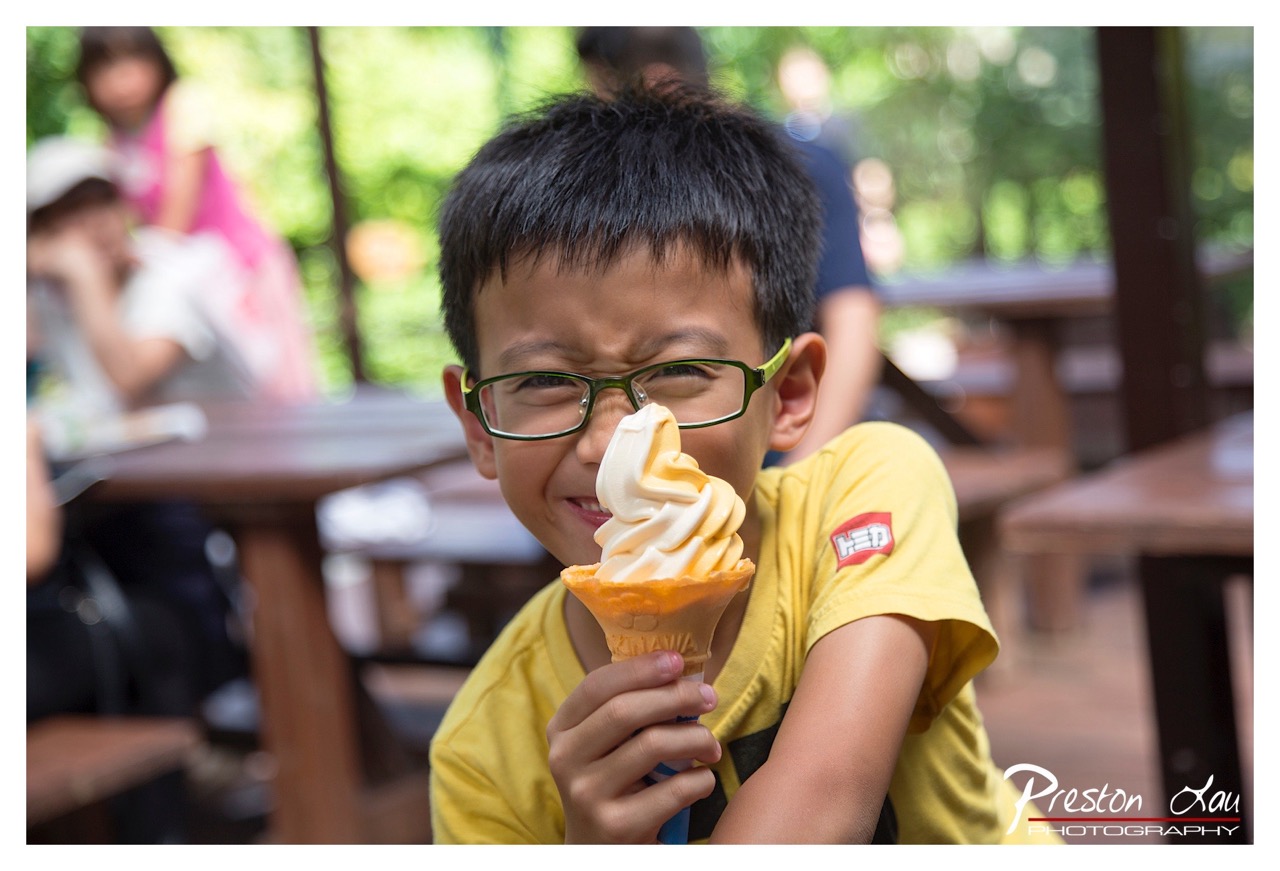

Title: The Ice Cream Intensity Face
Rating: Subject - 9/10
Meet the young maestro of dramatic dessert consumption, giving us his award-winning "pre-ice cream face," which frankly looks like a mixture of pure ecstasy and slight terror that the delicious swirl might escape. This kid is a goldmine for candid portraiture, earning a solid 9/10 for his utterly captivating and hilarious expression that immediately draws you into the scene. He's wielding a magnificent swirl cone, a tantalizing blend of vanilla and something golden – perhaps mango or caramel, judging by the delightful hue. The mood is undeniably playful and joyful, capturing a simple moment of childhood delight amplified by a truly epic facial contortion. It's the kind of face you make when you know you're about to experience something amazing, or maybe just when the camera is pointed at you and you decide to be a legend.
From a photographic standpoint, the composition is tight, focusing squarely on the boy and his frozen prize, leveraging a shallow depth of field to create that lovely, creamy bokeh that melts the background into soft blobs of color and light. This technique effectively isolates our subject, making sure that face and ice cream combo steals the show. The lighting appears to be soft, diffused natural light, possibly under a canopy or in dappled shade, beautifully illuminating the boy's face and highlighting the texture of the ice cream without harsh shadows. The vibrant yellow of his shirt pops against the blurred green backdrop of foliage and the warm tones of wooden tables, adding a cheerful energy to the frame. It's a great example of how a simple moment, captured with a wide aperture and attention to light, can become a memorable and humorous portrait.
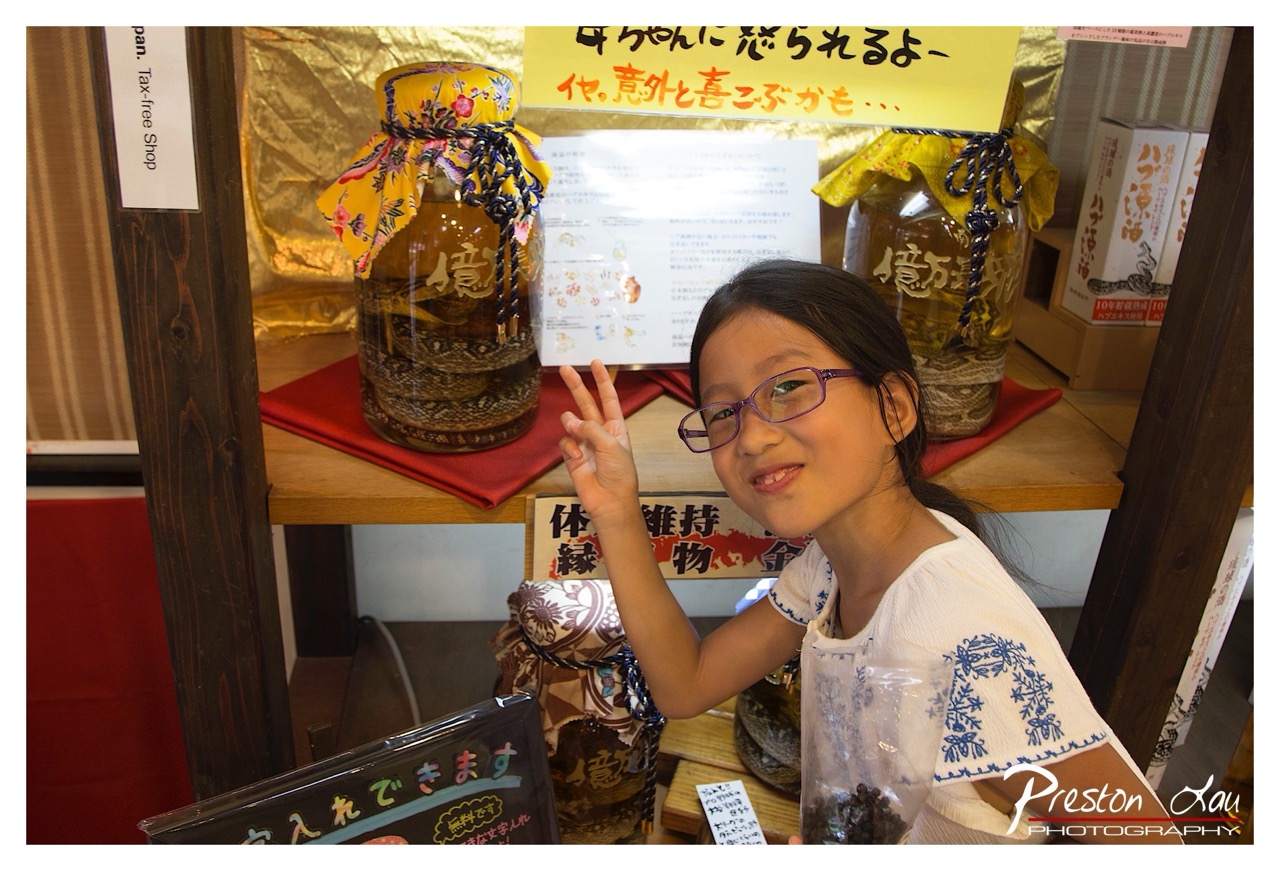

Title: Snake Charming Smile
Subject Rating: 8/10
Well, this is certainly a unique juxtaposition! Our delightful subject, a young girl sporting some rather stylish purple-rimmed glasses and a winning smile, flashes a peace sign right in front of what appears to be a tax-free shop display featuring giant jars of... pickled snakes. Yes, those are indeed snakes coiled up in amber liquid, likely some form of Habushu or snake wine, a traditional Okinawan beverage. She's holding a small bag of dark, unidentifiable items, possibly snacks or ingredients, completely unfazed by the scaly residents behind her. The background hints at a travel context, possibly Japan given the signs. The mood is surprisingly cheerful, almost playful, given the slightly macabre display, making you wonder if she finds the snakes fascinating or just finds the whole situation hilarious.
From a photographic standpoint, the composition places our young subject slightly off-center, which works reasonably well, though her hand and the bag do obscure some interesting background details. The lighting is quite effective, illuminating the girl's face and highlighting her expression, making her the clear focal point despite the visually arresting snake jars. The colors are warm, dominated by the wooden shelves and gold fabric, with pops of red from the display base and the girl's purple glasses and blue shirt embroidery. The focus is sharp on the girl, blurring the background just enough to separate her. It's a classic candid travel shot, capturing a moment of amusement and curiosity in an unusual setting. The watermark in the corner firmly places this image within the portfolio of "Preston Lau Photography," adding a professional touch to this delightfully quirky scene.
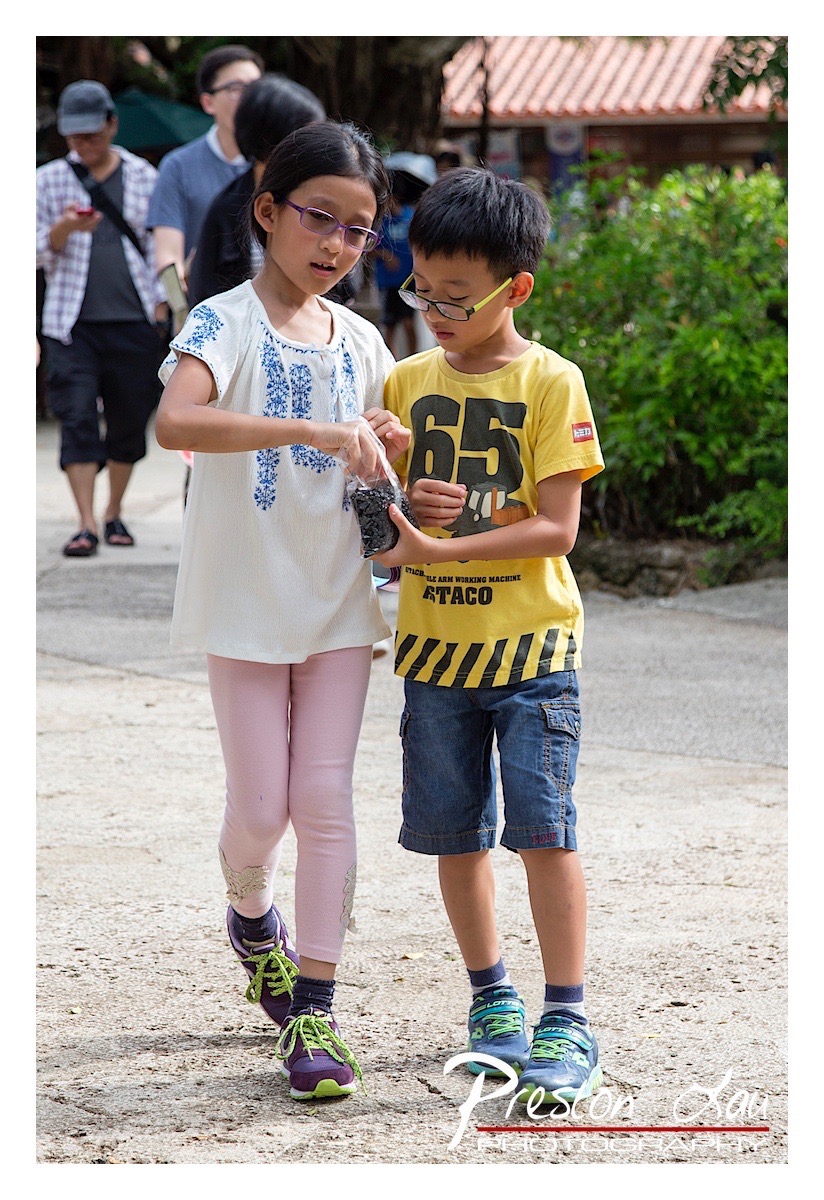

Title: The Snack Discovery Mission
Rating: 8/10
This image captures a wonderfully candid moment between two children, likely siblings or friends, engrossed in opening a small plastic bag containing dark, small objects – perhaps snacks or something they've collected. The subjects themselves are highly engaging; the girl's furrowed brow and careful fingers peeling open the bag, and the boy's intense, bespectacled gaze fixed on the operation, score them an 8 out of 10 for their captivating presence and natural interaction. Their contrasting outfits – the girl's soft white tunic with blue embroidery and pink leggings versus the boy's bold yellow "65" graphic tee and denim shorts – add visual interest and speak to their individual personalities. The mood is one of shared curiosity and focused activity, a universal scene of childhood exploration. The background features blurry figures walking past and lush green foliage under a tiled roof structure, hinting at a park, zoo, or outdoor event setting, providing context without pulling focus from the main subjects.
From a photographic perspective, the composition places the children slightly off-center, creating a more dynamic feel than a straight center crop. The choice of a shallow depth of field effectively isolates the children against the blurred background, directing the viewer's eye precisely where the action is happening. The lighting is typical of a bright, possibly mid-day, outdoor setting, leading to some noticeable highlights and shadows, but overall, the exposure is well-managed, ensuring the subjects are brightly lit. The color palette is vibrant, particularly in the children's clothing and shoes, which pop against the more muted tones of the path and background greenery. There's a watermark elegantly placed in the lower right corner, a standard practice for photographers to protect their work, although its white against the light path requires a second look to fully decipher. It's a great example of capturing an authentic, spontaneous moment that tells a small story within the frame.
Loading map...